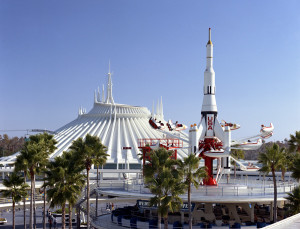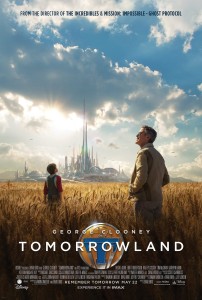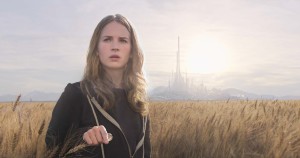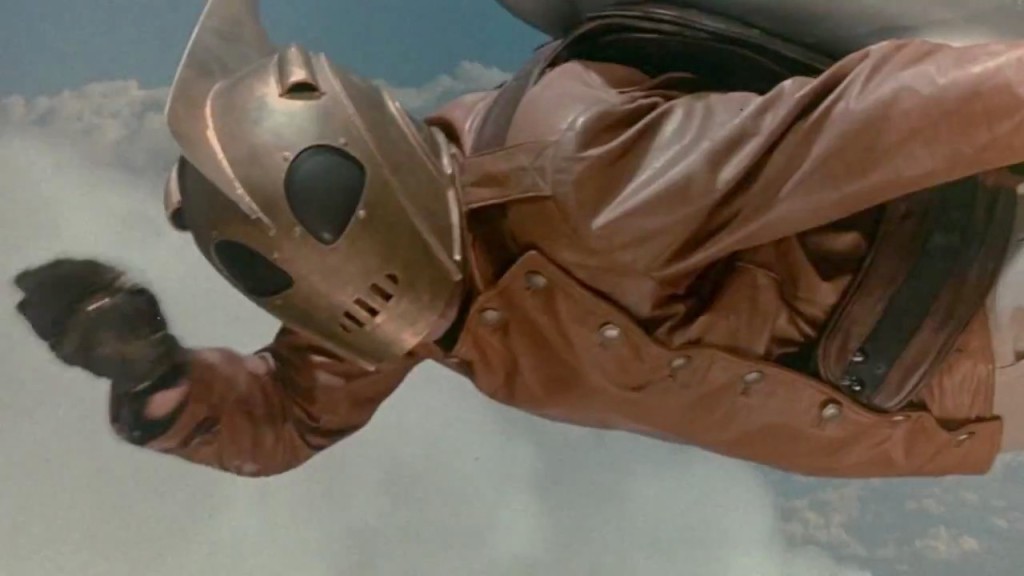 When Walt Disney Studios revealed that coming to theatres this summer was a movie called Tomorrowland, a feeling of dread (equaled only by my level of anticipation) welled inside of me. Tomorrowland—the park, not the movie—was a place that, even in my teenaged visits to Walt Disney World, I would hold my breath, make a wish, and lose myself in science fiction come to life. Tomorrowland was not just a special place, it was sacred. I remember visiting Walt Disney World when Space Mountain was under construction. (I’m old. Shut up.) I remember when their first spaceflight simulation “A Voyage to the Moon†convinced me had launched from Orlando and were en route to Tranquility Sea. Yes, I know—Walt Disney World is an amusement park. An expensive amusement park. Walt Disney World, I’ve always believed, has been less about the rides and more about the experience; and for me, nowhere else in the park embodied that more than Tomorrowland.
When Walt Disney Studios revealed that coming to theatres this summer was a movie called Tomorrowland, a feeling of dread (equaled only by my level of anticipation) welled inside of me. Tomorrowland—the park, not the movie—was a place that, even in my teenaged visits to Walt Disney World, I would hold my breath, make a wish, and lose myself in science fiction come to life. Tomorrowland was not just a special place, it was sacred. I remember visiting Walt Disney World when Space Mountain was under construction. (I’m old. Shut up.) I remember when their first spaceflight simulation “A Voyage to the Moon†convinced me had launched from Orlando and were en route to Tranquility Sea. Yes, I know—Walt Disney World is an amusement park. An expensive amusement park. Walt Disney World, I’ve always believed, has been less about the rides and more about the experience; and for me, nowhere else in the park embodied that more than Tomorrowland.
Now, it was a movie with George Clooney at the helm. And all I could think about was The Haunted Mansion.
Oh. Crap.
 Tomorrowland opens with George Clooney’s Frank Walker, attempting to record what appears to be a video journal, but off-camera he is constantly interrupted by Britt Robertson’s Casey Newton, a self-proclaimed voice of optimism. Through the false starts and interruptions, we discover that Frank—as a young boy—made an impression at the 1964 World’s Fair on a young prodigy, Athena, who recruited him to become part of an exclusive think tank known simply as Tomorrowland. Fast forward decades later and we dive into Casey’s story, a story of frustration that NASA is no longer reaching for the stars, where world politics and environmental changes are painting a bleak picture of what is to come, and her question of “What can we do to fix it?†remains unanswered. Still, Casey refuses to give up, and it is her unbreakable spirit that catches someone’s attention: a young prodigy named Athena.
Tomorrowland opens with George Clooney’s Frank Walker, attempting to record what appears to be a video journal, but off-camera he is constantly interrupted by Britt Robertson’s Casey Newton, a self-proclaimed voice of optimism. Through the false starts and interruptions, we discover that Frank—as a young boy—made an impression at the 1964 World’s Fair on a young prodigy, Athena, who recruited him to become part of an exclusive think tank known simply as Tomorrowland. Fast forward decades later and we dive into Casey’s story, a story of frustration that NASA is no longer reaching for the stars, where world politics and environmental changes are painting a bleak picture of what is to come, and her question of “What can we do to fix it?†remains unanswered. Still, Casey refuses to give up, and it is her unbreakable spirit that catches someone’s attention: a young prodigy named Athena.
The plot of Tomorrowland is hard to describe. It doesn’t happen so much as it unfolds around you, beginning with Frank’s story, then jumping to Casey’s point of view, and finally bringing these two together in a fantastic adventure to change the future and save the world; but while Tomorrowland appears on the surface a Campbellean “Chosen One†hero’s journey, there is a lot more happening here. From a visual perspective, Tomorrowland delivers a lot of awe and wonder in that classic Disney style, and manages to touch on three different styles of punk:
- Steampunk (The Eiffel Tower)
- Dieselpunk (Frank’s Electrolux Prototype Jetpack)
- Atompunk (Tomorrowland)
Never did any of these instances feel forced or contrived. In fact, Tomorrowland brilliantly reveals how steampunk eventually evolves into atompunk. The science fiction writer in me just relished that.
There are themes of lost innocence, skepticism, and apathy interwoven with the power of curiosity, optimism and determination. There is also a touch of darkness in Tomorrowland, something unexpected from what Disney himself created—a breathtaking vision of the future. The darkness, while prevalent, never overpowers; but like a minor key in music sets a sinister backdrop in the film. Governor Nix, explaining his frustration with the modern world, states:
“You’ve got simultaneous epidemics of obesity and starvation, explain that one. Bees and butterflies start to disappear, the glaciers melt, the algae blooms. All around you the coal mine canaries are dropping dead and you won’t take the hint! In every moment there’s a possibility of a better future, but you people won’t believe it. And because you won’t believe it you won’t do what is necessary to make it a reality.â€
Tomorrowland refuses to sugar-coat its sometimes-inconvenient messages without mercilessly beating you over the head with it. Amid some of the hiccups in the plot, this is not only refreshing, but welcomed.
What I can say won me over completely with Tomorrowland was its wide-eyed sense of wonder. This movie was far from the epic awesome of Avengers: Age of Ultron and nowhere near the overwhelming insanity of Mad Max: Fury Road, but that doesn’t mean that Tomorrowland was not a wonderful experience. How can I describe what I was feeling at the end of it?
The last time I felt this good, it was after seeing another Disney movie for the first time.
I found myself caught by surprise at the end of the film when I felt a tightness in my throat and tears in my eyes. I wondered for a moment, Athena’s words of “Dreamers need to stick together…†echoing in my mind, how long it had been since I felt this way? In growing older, in becoming a parent, had I forgotten to dream? Had I lost a bit of that curious, creative spirit I knew when I was younger?
Then I remembered something: I write steampunk. I had released a book with my beautiful wife, Pip, this past March; and only a few weeks ago, she picked up an award for the previous book in our series. We’re currently writing another steampunk adventure while brainstorming others.
Because dreamers need to stick together.
 Tomorrowland made me feel like I was visiting Walt Disney World for the first time, crossing the threshold to a world where nothing was impossible. It is a movie for the dreamers, for the optimists who look at each day as an opportunity to reach for the future, for those who refuse to give up. Perhaps it is flawed in places, but it makes up for shortcomings in its heart. It also assures the dreamers that giving up is not an option. It never was to begin with.
Tomorrowland made me feel like I was visiting Walt Disney World for the first time, crossing the threshold to a world where nothing was impossible. It is a movie for the dreamers, for the optimists who look at each day as an opportunity to reach for the future, for those who refuse to give up. Perhaps it is flawed in places, but it makes up for shortcomings in its heart. It also assures the dreamers that giving up is not an option. It never was to begin with.
As the credits rolled, our daughter turned to us and said,“I want to see it again.â€
Me too, Bear. Me too.

